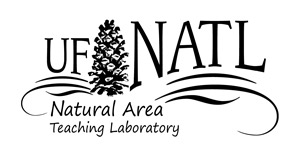| UF Academic Use | Public Use | Family Fun and K-12 Education |

History of NATL's upland pine, 1890 to 1990
This account relies heavily on the findings of Jeff Morton as described in his 2005 minigrant report, "Inferring NATL Site History."
The first cutting of large longleaf pines for sawtimber from what is now NATL probably occurred in the 1890's. Within a few years, in 1901, the property was bought at auction by Alice A. Richbourg from the estate of her father Rolin M. Witt. All or part of the area was later cultivated, as evidenced by the presence of an Ap soil layer at two sites just south of Division Trail. What was planted is not known. Whatever it was, it must have been in the presence of longleaf pines that were left standing as too small for the sawmill and that grew to marketable size and were harvested in about 1940, either shortly before or shortly after the property was deeded by Donald J. Richbourg (husband of Alice, by then deceased) to Claude C. Richbourg (adopted son of D.J. and A.A. Richbourg). This second cutting is evidenced both by coring of selected trees (Morton 2005) and a comparison of aerial photographs made in 1937 and 1949. The second cutting was again for sawtimber, and trees less than about 30 cm DBH were left standing.
C. C. Richbourg and his wife sold the property to the State of Florida in 1944. The area was grazed prior to this time, as shown by the remnants of livestock trails in the 1949 aerial photograph. It happens that 1949 was the year that Florida went from being an open range state, where land owners had to fence livestock out, to the present situation, where livestock owners are required to fence their animals in. Thus the livestock, probably cattle, that made the trails did not necessarily belong to the owners of the land.
When UF acquired what is now NATL's upland pine, its vegetation was scattered longleaf pines and an understory of scrubby turkey oaks. This is supported by the 1949 aerial photograph and by what I remember of the area when I collected insects there beginning in 1958. The University did nothing to use or manage this portion of the 1944 purchase prior to it becoming NATL. During this 50-year period (1944-1994) laurel oaks invaded and prospered and by 1990 had formed a continuous understory that shaded out most of the turkey oaks and prevented reproduction of the longleaf pines. The course of this transition is illustrated by eight aerial photographs, from 1949 through 1990, used to illustrate George Freeman's account of the post WWII history of what became NATL.
Restoration of NATL's upland pine ecosystem was a major management goal in the original proposal for NATL (1993). The details of what has been accomplished thus far are described in Management of NATL's upland pine, 1993 to date.
T. J. Walker
January 2006


